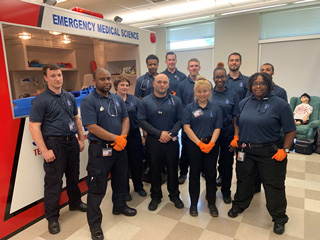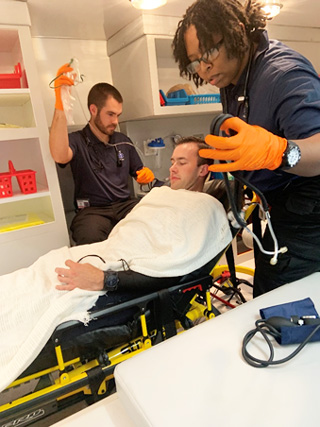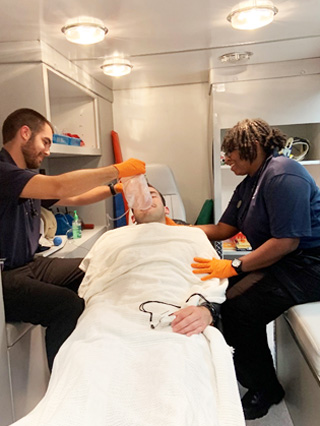Macon Cove Campus ambulance simulator adds real life feel to EMT training
Rachel Trigg used to set up chairs inside her classroom to simulate where the benches would be inside of an ambulance. Another student would sit in a chair holding a pie plate for a steering wheel driving the “ambulance.” And in drills, Trigg would sometimes stand still and pretend to be a wall so the students would have to work around her to simulate a real life emergency medical technician (EMT) situation.

Emergency Medical Technician students at the Macon Cove Campus show off the new ambulance simulator.
Students in the EMT classes won’t be using chairs any more or holding pie plates to simulate the inside of an ambulance. The Macon Cove Campus now has its very own ambulance simulator to give students a glimpse of what it’s like to work inside of a modern day ambulance. The simulator was moved from the Union Avenue Campus after a new, state-of-the-art simulator was installed there thanks to an $85,000 Advance Southwest grant.
Union Avenue’s 10-year old simulator was refurbished and moved to the Macon Cove Campus so that EMT students there may have as close to a real situation as you can get in a classroom setting. “We are very grateful to have this,” Paramedic and Emergency Medical Technology Instructor Rachel Trigg said.
The simulator doesn’t actually move, but Trigg says it looks very similar to the inside of some ambulances. It has flashing lights, inside lights, and is equipped with all of the features and equipment that an EMT would find inside a real ambulance. “If a real ambulance pulled up, our EMT students would know their way around,” said Trigg. “Some ambulances may have different things inside. This one doesn’t have outside compartments, for example, where the long spine board is. But it is really close.”
Trigg says running a scenario in a simulator gives the students the closest familiarity to what they will experience in the field. “I’ve been on a real ambulance,” Trigg said. “The first time I got to use this, I knew the students would love it.”
Trigg says students will perform such drills as loading a patient on a gurney and simulating real-life emergency situations—everything from a heart attack to trauma situations where limbs have been severed to delivering a baby. Sometimes she even plays with them a little and tells them that the driver just made a sharp left turn and they all have to lean to the left to simulate working in traffic. “They are going to perform like the way they practice,” Trigg said. “They can now load a stretcher into this. They flip on the interior lights. They turn on the outside lights. They have a patient with them. They even play the patients. It’s more close corners. This is way more empowering,” Trigg added. “We have a saying. They don’t practice until they get it right. They practice until they can’t get it wrong. So this is some great hands-on training.”
Trigg says the usual reaction from students when they see the simulator for the first time is ‘cool’ and that “they love it.”
EMT student Destinie Ransom said it feels like a real ambulance. “It’s more like real life,” Ransom said. “I think it will make our training a lot more real.” Student Cole Gwin agrees. “It looks like a real ambulance,” Gwin said.

EMT students Cole Gwin and Destinie Ransom stabilize their trauma victim
classmate Noah Johnson.

The simulator approximates the close quarters inside an ambulance where all of the life-saving equipment is located.
In This Issue...
- From President Tracy D. Hall
- Adjuncts saluted at awards dinner
- FROM THE EDITOR-IN-CHIEF
- AACC appoints President Hall to economic and workforce development commission
- Men’s Huddle prepares high school males for college life and beyond
- International Studies seeks faculty, staff advisors to choose Spring 2020 trips
- Welcome aboard, new team members
- Freshman Josue Flores finds a home in America at Southwest
- Summer Institute explores ways to close student achievement gaps
- EMPLOYEE OF THE MONTH: Business and Technologies Secretary Karen Taylor
- New Student Orientation takes show on the road with NSO on the Go
- Macon Cove Campus ambulance simulator adds real life feel to EMT training
- HR CORNER: Tennessee adopts new worker’s compensation injury claim reporting guidelines
- Quality center trains ER chief/brigadier general in Lean Six Sigma
- SALUQI CORNER
- Ordering paper just got easier
- State announces incentive program to encourage timely reporting of automobile accidents
- CULINARY CORNER WITH CHEF STEVEN LEAKE
- Fuel for Finals reboots for Spring Semester
- Southwest: In the News